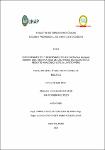Enteroparásitos y hemoparásitos en Trichechus inunguis Natterer, 1883, según áreas de cautividad en el Centro de Rescate Amazónico (CREA), Loreto-Perú

View/
Date
2022Author
Macedo Tafur, Franco Ivan
Ruiz Pezo, Jim Werner
Metadata
Show full item recordAbstract
The main threat that affects the Amazonian manatee is the contamination of rivers that facilitates the spread of parasitic diseases; therefore, the present study had the objective of determining the prevalence of enteroparasites and hemoparasites in Amazonian manatees of the Amazonian Rescue Center. Twenty-eight samples were obtained from 10 male and female manatees, including calves, juveniles and adults. Fecal samples were obtained by direct deposition and blood samples by direct extraction from the pectoral fin. For the detection of intestinal parasites, the direct method, Willis flotation and Kinyoun staining were used. For hemoparasites, direct observation of blood and thick drop with Giemsa staining was performed. The following Protozoa were recorded: Eimeria oocyst 1,2 and 3, Cyclospora, Cryptosporidium, Entamoeba cyst; and Helminths, as eggs of Ascaride 1 and 2, Oxyuridae, Ancylostomatidae, Nematode 1, 2 and 3, and a Trematode; with the highest prevalence being Eimeria (3) 100% and Cyclospora 80%. According to the areas of captivity, pre-release was the area with the highest number of enteroparasites recorded, as well as juveniles and the Fundo Furia facility, while in females and males their presence was indistinct. Statistically, these results were independent of the variables studied. No blood parasites were recorded in the samples obtained. La principal amenaza que afecta al manatí amazónico es la contaminación de los ríos que facilita la propagación de enfermedades parasitarias; de esta manera la presente investigación tuvo como objetivo determinar la prevalencia de enteroparásitos y hemoparásitos en manatíes amazónicos del Centro de Rescate Amazónico. Obteniéndose 28 muestras de 10 manatíes hembras y machos, entre crías, juveniles y adultos. Las muestras fecales fueron obtenidas por deposición directa y las muestras sanguíneas por extracción directa de la aleta pectoral. Para la detección de parásitos intestinales se utilizó el método directo, flotación de Willis y coloración de Kinyoun. Para los hemoparásitos se realizó observación directa de sangre y gota gruesa con tinción Giemsa. Se registraron los siguientes Protozoarios: ooquiste de Eimeria 1,2 y3, Cyclospora, Cryptosporidium, quiste de Entamoeba; y Helmintos: como huevos de Ascaridae 1 y 2, Oxyuridae, Ancylostomatidae, Nematodo 1,2 y 3, y un Trematodo; siendo los de mayor prevalencia ooquiste de Eimeria (3) 100% y Cyclospora 80%. En las áreas de cautividad, preliberación registró mayor número de enteroparásitos, así como en juveniles y en Fundo Furia, mientras que en las hembras y en los machos su presencia fue indistinta. Estadísticamente, estos resultados fueron independientes a las variables estudiadas. No se registraron parásitos sanguíneos en las muestras obtenidas.
Collections
- Tesis [418]

